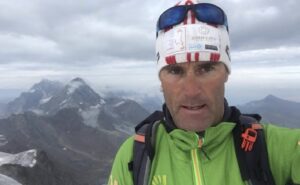Two days ago, we reported that Horia Colibasanu, Marius Gane, and Peter Hámor survived an avalanche that buried them while they slept in their tent.
Today, Colibasanu announced that after this very close call, they will go home rather than venture again up Dhaulagiri’s NW Ridge in these conditions. So their valiant effort, their closest in three tries, ends.
Colibasanu’s description of that night at at 6,800m makes their prudence understandable. Though a serac partly sheltered their camp from the full brunt of the avalanche, it buried their tent under one metre of snow. They had to fight for their lives while gasping for air. Colibasanu recalled those harrowing moments in an interview in Romanian.
“We’d never before experienced an avalanche from inside…It literally crushed us in the tent. We tried to keep a small air pocket around our mouths…When the avalanche stopped, it was completely dark. Although all three of us were in the same tent, I couldn’t hear my colleagues. Everything was quiet. All I could do was search for my pocket knife. I knew this was the procedure in case of an avalanche falling on a tent. If you don’t cut open the tent, you can’t get out. I felt there wasn’t any more air. I pulled the knife and cut open the tent. Then I had to push through that metre of snow to escape, charged with adrenaline. I managed to get my hand out first, the hand with the knife…and finally breathe.”
A projected long spell of bad weather compounded with the objective hazards of the route “are unacceptable,” Peter Hamor’s team reported. The forecast calls for days of consistently clear mornings, snowy afternoons, and strong winds.

Climbers walk towards BC at the foot of the Northwest Spur. Photo: Peter Hamor
“The dream of a first ascent of the Northwest Ridge has vanished” in the face of deteriorating weather, they said.
In the end, they had managed to forge a line up the rocky spur, which was one of the main technical problems of the entire route, and started along the ridge itself for the first time.
Base Camp almost deserted
Meanwhile, Base Camp at the foot of the normal route, once bustling with nearly 200 people, is now virtually deserted. For them, it was primarily the same avalanche danger that forced back forerunners Carla Pérez and Topo Mena. The worsening threat of COVID-19 added to the uncertainty.
Only two teams now remain, Carlos Soria’s and Said Mirzaei’s. Earlier today, in an interview with Desnivel, Soria explained that last week, 36 climbers left Base Camp to try for the summit. “The Sherpas knew very well that it was impossible,” he said. “It is something they do to keep customers happy.”
He went on: “Three of the Sherpas reached lower Camp 3, the one at 7,000m, not the one at 7,300m. The rest of the group waited for two days in Camp 2.”
But because of the amount of snow on the mountain, the Sherpas could not fix ropes and there was no chance of proceeding further. “They didn’t fail to summit because of COVID but because of the conditions on the mountain,” he said.
Nevertheless, five of the 36 came down early because they felt unwell and most tested positive for COVID. Of the 31 left, 11 tested positive back in Base Camp, said Soria.
Soria initially said that he felt safer on the mountain than in Kathmandu. He wanted to wait until May 15, hoping the airport would open. Then he heard that the ban on international flights extended until June 1. At last word, he and everyone else have changed their minds and have asked to fly back to Kathmandu.






